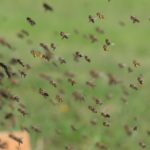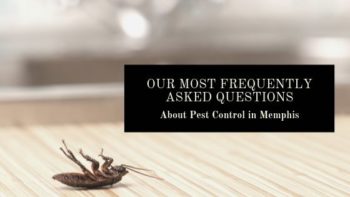
There are over 2,000 species of fleas, and every last one of them is a pest. They’re resilient, and hard to get rid of.
But not impossible.
We’ll tell you everything you need to know and exactly how to get rid of fleas – for good.
What Are Fleas?
Fleas are tiny blood-sucking parasites no more than a few millimeters long. The like hot humid climates, so places up north tend to get a reprieve from flea season. Every winter wills off a lot of the population and makes the rest go dormant.
Fleas drink blood. That’s why we most often find them on our pets. But they can live on any warmblooded creature. That includes wildlife like deer, skunks, bear, and raccoon. They can even live off you.
Some people are deathly allergic to flea bites, and they go into anaphylactic shock. If that happens to you, use an emergency EpiPen if you have one and immediately call 911.
But for most people, they’re more annoying than deadly.
The Flea Life Cycle
Understanding a flea’s life cycle can help you better control the fleas in your home. Each stage has to be treated differently. On average, fleas live for 30 to 90 days. But in the larval stage, they can go dormant for months.
Eggs
To make eggs, a female flea has to have available food – usually your pet. After a blood meal, she’ll lay up to 40 tiny white eggs on your pet’s skin every day. The eggs are small, smaller than a grain of sand.
As your pet walks around their environment, the eggs fall off and disperse. This infests carpets, fabrics, and especially the areas where your pet sleeps.
At this stage, it’s important to regularly bathe your pet. With any luck, you’ll be able to wash them down the drain before they can get into your home.
Eggs last anywhere from two days to two weeks. They like warm, humid environments where they think food is close. The surrounding temperatures will affect how long before the egg hatches
Larvae
The larvae stage lasts from about 5 to 20 days. They’re tiny almost translucent like worms that are usually no more than 1/4th inch long. They avoid light. Instead, they burrow into your carpet and fabric where they go unnoticed.
Most of the time, about 35% of the flea population in a given household is in the larvae state.
You can vacuum daily or use household pesticides with a growth regulator. The growth regulator will keep the insect from going on to the next life stage.
Larvae feed off organic debris in the house, like dust, dead skin, and flea dirt. Flea dirt is coagulated blood that’s already been digested and disposed of by adult fleas.
Regular vacuuming cleans up the food larvae need to eat. With less food, it’s harder for the larvae to survive.
Pupae
Another 10% of the flea population is typically in the pupae stage. The pupae is the cocoon the larvae flea makes before becoming a full-fledged adult flea. It can last anywhere from a few days to a few weeks. But some pupae will protect the adult flea for several years if conditions are bad.
The pupae stage is resistant to household pesticides. Since the chrysalis is sticky, they’re hard to get out of the carpet with only a light vacuuming or sweeping. Sometimes professional carpet deep cleans can help get rid of flea pupae.
Vacuum anyway. The vibrations trick the pupae into thinking there’s a large, edible animal close by. They think conditions are favorable. So they’re more likely to move onto the next stage more quickly.
Adult Flea
Like a hungry vampire, if a flea doesn’t feed on a host within a few hours, it will die.
Within a few hours after their blood meal, they’ll start to lay eggs and the cycle starts over again.
Most often, when you notice fleas in your home, they’ll be adults. They have an iconic shape, with a tiny body and even tinier legs. They’re easiest to recognize when they’re in the water. They float on their sides and you can better see their profile.
On your pet or in your home, they tend to look longer and flat, and they don’t have that distinct shape from a top view. Try to catch some off your pet with a flea comb so you can get a better view.
Here’s the scary part: Adult fleas only make up about 5% of the entire population in the home. So the fleas you can see are barely the start of it.
Where Do Fleas Come From?
Fleas will get into your home most often via your pets. They live in areas of your yard that are weedy or dense with fallen leaves. When a host walks by, they hop on and catch a ride.
Your pets can also pick them up from other animals, like wildlife, strays, or untreated dogs at the park.
Even if your dog is healthy, they can still easily get fleas. So make sure they’re on a reputable flea preventative. If you’re in a terrible flea area, like Florida, take your pet to the vet. You can get a prescription flea preventative – it’s worth it.
How Do I Know If I Have Fleas?
Most likely you’ll first notice fleas by watching your pet’s behavior. They’ll tend to be itchier than usual.
Start by looking for flea bites on your pet. Check underarms and bellies, since this will be the most likely place you can see the bites. They’ll look like little red bumps.
But even if you don’t see bites, your dog might still have fleas. Look for flea dirt in your pet. Cats are self-cleaning, so you may not find any. You could still have fleas.
Flea dirt in dogs is easy to find. Check especially at the base of the tail, since it’s hard for most dogs to lick that spot. Flea dirt will feel like very coarse dirt, like dirt that has caked up in the dog’s natural skin oils.
Sometimes that’s all it is – dirt caked in a dog’s skin oils. Flea dirt will be dark, almost black. To know for sure, put some flea dirt on a white paper towel and get it just barely damp. Mist it with a spray bottle for optimal results.
Then smear the dirt over the paper towel. Does it leave a dark rusty smear? Then it’s almost inevitably flea dirt.
As we mentioned above, flea dirt is essentially flea feces. It’s clumps of blood that an adult flea has already processed and relieved on your pet’s skin.
If you’re still not sure, get a flea comb. Flea combs are very fine-toothed combs designed to trap fleas between their teeth. Whenever you comb for fleas, keep a tub of water with dawn soap next to you. This is so you can rinse out any bugs and keep them from hopping back into your home.
How Can I Treat Flea Bites?
So you have fleas. If this is your first time experiencing fleas, it can be frustrating. You may even feel embarrassed if you grew up in an area that was relatively flea free.
Don’t be. Most likely, fleas are a seasonal thing. Flea season is just like mosquito season or any other summer pest. When you tell your friends your pet brought home fleas, they’ll have stories of their flea trouble.
Getting the issue under control so you and your pets can live comfortably is the next important step.
To treat flea bites, get anti-itch cream like caladryl calamine. If you or your pets are particularly bothered, get Benadryl. It comes in a pet form too, and it can help relieve the itch.
Call your vet especially if you live in an area where fleas are particularly bad. They can prescribe extra strength flea medication to protect your pet. They can even prescribe medication that kills fleas on contact. This can help keep your infestation from getting worse.
Once you’re not suffering from flea bites anymore, you can go on to treating the issue directly.
Treat the Issue
Once the itching is under control, you can tackle the fleas directly. Let’s start with your pets. If possible, try to figure out where your pet got fleas in the first place. It may be a strange dog park you went to, or it may be a spot in your yard.
Try to avoid those places to avoid reinfestation, and clean up your yard to keep a safe home.
Since your pets are likely the biggest factor, get them on a flea control medication. Give them regular baths to wash out adult fleas and flea eggs.
Do not use flea soap on your pets. Some flea soaps meant for dogs will kill cats. And other flea soaps can make your pets sick. Dawn dish soap works perfectly fine.
You may want to consider grocery store flea control spray. That may help but get a reputable brand. It’ll be more expensive, but it will be safer for your home and your pets. It’ll be more effective too.
Keep your home clean. Vacuum and sweep daily and clear your yard of any place fleas might like to hide. A good defense is your best offense when it comes to fleas.
Regularly vacuum upholstery and wash anything your pets regularly sleep on.
Use These Tips to Show You How to Get Rid of Fleas
Fleas are troublesome, frustrating pests. But now you know how to get rid of fleas from your pets and out of your home. If you want professional help to get rid of fleas quickly, call us today.
Worried your home may be infested with pests? We can help. Get a free pest control estimate today!





